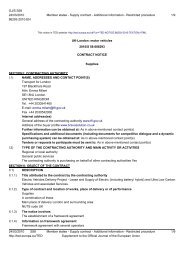Life cycle costing (LCC) as a contribution to sustainable construction ...
Life cycle costing (LCC) as a contribution to sustainable construction ...
Life cycle costing (LCC) as a contribution to sustainable construction ...
Create successful ePaper yourself
Turn your PDF publications into a flip-book with our unique Google optimized e-Paper software.
Towards a common European methodology for <strong>Life</strong> Cycle Costing (<strong>LCC</strong>) – Guidance Document<br />
51<br />
Cost (NVP)<br />
maintenance<br />
and<br />
replacements<br />
12000<br />
10000<br />
Cost (NPV) of maintenance and replacements<br />
8000<br />
1000 kr<br />
6000<br />
4000<br />
2000<br />
0<br />
5 10 15 20 25 30 35 40 45 50 55<br />
Year (appraisal periode 40 years)<br />
Results (continued)<br />
The results constituted an overview of individual cost<br />
components’ <strong>contribution</strong>s <strong>to</strong> annual costs, and their<br />
apportionment with regard <strong>to</strong> responsibility and cost. This<br />
apportionment is in accordance with Statsbygg’s standard le<strong>as</strong>e.<br />
A similar overview, calculated on a square metre b<strong>as</strong>is,<br />
accompanies the first results. Further on there are sheets showing<br />
the detailed calculation.<br />
Management costs include property tax, water and sewer fees,<br />
refuse collection and disposal, insurance and administration.<br />
Energy use and cost is a main focus. Energy for heating<br />
(building, ventilation and hot water) is supplied by district<br />
heating. Electricity is <strong>as</strong>sumed for all other purposes. The energy<br />
price w<strong>as</strong> b<strong>as</strong>ed on existing contracts (in accordance with the<br />
owner). These prices were quite low, and a sensitivity analysis<br />
w<strong>as</strong> recommended for further work.<br />
Conclusions and benefits<br />
The main conclusion from the <strong>LCC</strong> analysis<br />
recommended a stronger focus on energy<br />
use. The architectural and technical design<br />
at the pre-project ph<strong>as</strong>e would give higher<br />
energy use than best practise and in<br />
comparison <strong>to</strong> the new regulations on<br />
energy use in buildings.<br />
Due <strong>to</strong> costs and progress of the project, the<br />
conclusions of the analysis w<strong>as</strong> only partly<br />
taken in<strong>to</strong> action.<br />
Davis Langdon Management Consulting May 2007







